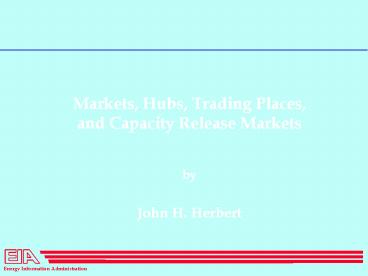Public Utilities - PowerPoint PPT Presentation
1 / 25
Title:
Public Utilities
Description:
Energy Information Administration. A Lot of Interesting Market Developments ... Energy Information Administration. Why Is There So Much Short Term Price Risk? ... – PowerPoint PPT presentation
Number of Views:1862
Avg rating:3.0/5.0
Title: Public Utilities
1
Markets, Hubs, Trading Places, and Capacity
Release Markets by John H. Herbert
2
Summary
This presentation describes new trading
environments for natural gas commodity and
transportation services. It also identifies the
factors that influenced the development of these
environments. Actual examples are provided that
show how these and other developments can be used
to fix the price of gas and to provide other
commercial benefits.
3
A Lot of Interesting Market Developments
4
West Texas Market Centers Interplay With North
and East Texas and Loiusiana Market Centers
5
Streamline Auction Market Volume Traded
6
Energy Exchange Auction Market -Intra-Alberta
(Number of Trades)
7
Price Risk and Market Centers and Hubs
- How Much Price Risk or Volatility is There?
- A Lot!
8
Volatilities - NYMEX Natural Gas Futures Market,
November 1996 To May 1997
- Most commodities average volatilities below 20
9
Why Is There So Much Short Term Price Risk?
Weather events - there is no commodity in which
the demand varies more in the short term Other
Reasons
- New Inventory Management Strategies
- Fuller Use of Existing Pipeline Capacity
10
Responses To Short Term Price Volatility
- Flexibility in Contracting and in Services -
Market Hubs and Centers
11
Encouraging Trade
- Market Hub, Market Centers, and Auction Markets
Should Encourage Trade Between Gas Sellers and
Buyers Where a Buyer can be a Seller and a Seller
can be a Buyer
12
Encouraging Exchanges
- Capacity Release Markets Should Also Encourage
Exchanges. An Increase in the Volume of Capacity
Releases Could Indicate an Increase in the Number
of Exchanges of the Commodity.
13
Encouraging Exchanges
- An Increase in the Number of Capacity Exchanges
Could Indicate a Decline in the Subscription for
Firm Capacity. This Would Exacerbate the
Capacity Turnback Problem.
14
Constant Trading - Firm Capacity
- Constant Trading Works Well as Long as a Company
Has Firm Capacity
15
Constant Trading - Pipe Capacity
- Constant Trading can Work even Better if Company
Trades Pipe Capacity the Same Way it Trades the
Commodity
16
Constant Trading - Release Capacity
- Constant Trading Works Best for a Company When
the Price of Release Capacity is Independent of
the Price of Commodity
17
Constant Trading Can Fix or Hedge Price
- 1. Determine average requirements during some
period. - 2. Determine whether incremental demands are
independent of price. - 3. If 2 is satisfied, enter a contract for
average requirement during some period at a
particular price, say 2.00 MMBtu.
18
Constant Trading Can Fix or Hedge Price
- 4. Then purchase gas when daily requirements are
above average requirements. - 5. And sell gas when daily requirements are below
average requirements. - 6. This simple strategy essentially fixes the
cost of gas at 2.00 MMBtu. - 7. It depends on whether a company has access to
a market such as an electronic daily auction
market.
19
A Numerical Example of Constant Trading Strategy
Action
Needs
- Day 1 600 Buys 100 Mcf at 2.20 -200.00
- Day 2 550 Buys 50 Mcf at 2.30 -150.00
- Day 3 300 Sells 200 Mcf at 2.20 400.00
etc., if the customer has done the work right the
s and -s cancel out and the customer effectively
fixes the cost
20
An Example for Figuring Out the Effective Cost of
Firm Capacity
21
Transportation Costs and Cost of Unused Capacity
To obtain the cost of unused capacity
- Total Cost of Firm Transportation
- - Revenues from Capacity Release
- Net Cost of Transportation
22
Transportation Costs and Cost of Unused Capacity
- Total Cost of Firm Transportation
- Amount Contracted
Net Transportation Cost Amount Used
-
CU
CU Cost of Unused Capacity per Unit Used
23
Transportation Costs and Cost of Unused Capacity
An Example,
100,000 200,000 Mcf
90,000 100,000 Mcf
-
0.90 Mcf - 0.50 Mcf 0.40
Mcf
Thus the cost of unused capacity per unit is
0.40 Mcf
24
The Volatility Bargain
- Short term volatility is likely to be sustained
as long as the bargain that short-term volatility
implies a better allocation of the commodity in
the short-term, and a better allocation of
capital in the mid-term.
25
The Volatility Bargain
- Volatility bargain suggests a drop in capital
cost per dollar of deliverability when moving
from a highly regulated industry to a less
regulated industry. This means continued
increases in capacity turnbacks unless aggregate
demand increases significantly.































